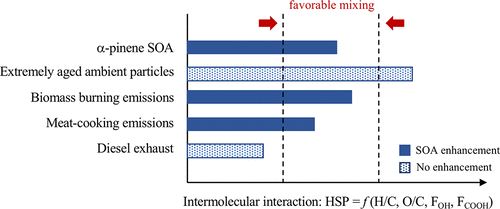当前位置:
X-MOL 学术
›
ACS Earth Space Chem.
›
论文详情
Our official English website, www.x-mol.net, welcomes your feedback! (Note: you will need to create a separate account there.)
Predicting Secondary Organic Aerosol Enhancement in the Presence of Atmospherically Relevant Organic Particles
ACS Earth and Space Chemistry ( IF 3.4 ) Pub Date : 2018-08-24 00:00:00 , DOI: 10.1021/acsearthspacechem.8b00093 Jianhuai Ye 1 , Paul Van Rooy 2, 3 , Cullen H. Adam 1 , Cheol-Heon Jeong 1, 4 , Bruce Urch 4, 5 , David R. Cocker 2, 3 , Greg J. Evans 1, 4, 5 , Arthur W. H. Chan 1, 4
ACS Earth and Space Chemistry ( IF 3.4 ) Pub Date : 2018-08-24 00:00:00 , DOI: 10.1021/acsearthspacechem.8b00093 Jianhuai Ye 1 , Paul Van Rooy 2, 3 , Cullen H. Adam 1 , Cheol-Heon Jeong 1, 4 , Bruce Urch 4, 5 , David R. Cocker 2, 3 , Greg J. Evans 1, 4, 5 , Arthur W. H. Chan 1, 4
Affiliation

|
Secondary organic aerosol (SOA) produced from atmospheric oxidation of organic vapors comprises a large portion of ambient particulate matter. Currently, SOA models typically assume that all organic species form a well-mixed phase as a simplification, which follows that SOA formation is enhanced in the presence of pre-existing organic aerosol (OA) according to Raoult’s Law. In this work, we show through experiments with atmospherically relevant OA that not all organic species are equally miscible, and the thermodynamics of mixing are composition dependent. SOA formation from α-pinene ozonolysis was investigated in the presence of OA that was collected from Toronto ambient air and other sources including biomass burning, meat-cooking emissions, and diesel exhaust. Compared to experiments with ammonium sulfate seed particles, enhanced SOA yields were observed with particles from biomass burning and meat cooking but not with diesel exhaust and concentrated ambient particles. We demonstrate that both kinetic (bulk diffusion-limitation) and thermodynamic (miscibility-limitation) factors are important in determining atmospheric organic aerosol partitioning. We develop parametrization methods using bulk elemental ratios (H/C and O/C) and functional group abundance (ROHand RCOOH) to estimate average intermolecular interactions, which allow us to use Hansen Solubility Framework we had previously developed to predict atmospheric organic aerosol miscibility and SOA yield enhancements in these complex mixtures. The framework has also been utilized to better understand the liquid–liquid phase separation between organic aerosol and inorganic salts. Our results show that a molecular description of thermodynamic forces is needed to describe aerosol mixing in the atmosphere and accurately parametrize SOA formation.
中文翻译:

在大气相关有机颗粒的存在下预测次要有机气溶胶的增强
由大气中有机蒸气的氧化产生的次级有机气溶胶(SOA)包含很大一部分环境颗粒物。当前,SOA模型通常假设所有有机物种都为简化形式而形成良好混合的相,因此根据Raoult定律,在存在预先存在的有机气溶胶(OA)的情况下,SOA的形成会增强。在这项工作中,我们通过与大气相关的OA进行的实验表明,并非所有有机物种都可同等地混溶,并且混合的热力学取决于成分。在存在OA的情况下,研究了α-pine烯臭氧分解过程中SOA的形成,OA是从多伦多环境空气和其他来源收集的,包括生物质燃烧,肉类烹饪排放物和柴油机废气。与使用硫酸铵种子颗粒进行的实验相比,使用生物质燃烧和肉类烹饪产生的颗粒观察到SOA产量提高,但柴油机排气和浓缩的周围颗粒观察不到。我们证明,动力学(体扩散限制)和热力学(混溶性限制)因素在确定大气有机气溶胶分配中很重要。我们使用体质元素比率(H / C和O / C)和官能团丰度(ROH和R COOH)来估计平均分子间的相互作用,这使我们能够使用之前开发的Hansen溶解度框架来预测这些复杂混合物中大气有机气溶胶的混溶性和SOA产率的提高。该框架还被用来更好地理解有机气溶胶和无机盐之间的液相分离。我们的结果表明,需要用热力学力的分子描述来描述大气中的气溶胶混合并准确地参数化SOA的形成。
更新日期:2018-08-24
中文翻译:

在大气相关有机颗粒的存在下预测次要有机气溶胶的增强
由大气中有机蒸气的氧化产生的次级有机气溶胶(SOA)包含很大一部分环境颗粒物。当前,SOA模型通常假设所有有机物种都为简化形式而形成良好混合的相,因此根据Raoult定律,在存在预先存在的有机气溶胶(OA)的情况下,SOA的形成会增强。在这项工作中,我们通过与大气相关的OA进行的实验表明,并非所有有机物种都可同等地混溶,并且混合的热力学取决于成分。在存在OA的情况下,研究了α-pine烯臭氧分解过程中SOA的形成,OA是从多伦多环境空气和其他来源收集的,包括生物质燃烧,肉类烹饪排放物和柴油机废气。与使用硫酸铵种子颗粒进行的实验相比,使用生物质燃烧和肉类烹饪产生的颗粒观察到SOA产量提高,但柴油机排气和浓缩的周围颗粒观察不到。我们证明,动力学(体扩散限制)和热力学(混溶性限制)因素在确定大气有机气溶胶分配中很重要。我们使用体质元素比率(H / C和O / C)和官能团丰度(ROH和R COOH)来估计平均分子间的相互作用,这使我们能够使用之前开发的Hansen溶解度框架来预测这些复杂混合物中大气有机气溶胶的混溶性和SOA产率的提高。该框架还被用来更好地理解有机气溶胶和无机盐之间的液相分离。我们的结果表明,需要用热力学力的分子描述来描述大气中的气溶胶混合并准确地参数化SOA的形成。



























 京公网安备 11010802027423号
京公网安备 11010802027423号